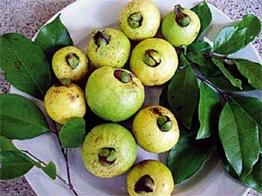Psidium friedrichsthalianum
Psidium friedrichsthalianum, commonly known as the Costa Rican guava or cas guava, is a species of guava native to Central America, particularly found in countries such as Costa Rica, Panama, and parts of Nicaragua. This tropical fruit tree is part of the Myrtaceae family, which includes other significant and economically important species such as the common guava, Psidium guajava.
Description[edit | edit source]
Psidium friedrichsthalianum is a small to medium-sized tree that can reach heights of up to 10 meters. It has a spreading canopy with smooth, copper-colored bark. The leaves of the Psidium friedrichsthalianum are simple, opposite, and elliptic with a glossy green appearance. The flowers are white, with numerous stamens, and are borne singly or in small clusters in the leaf axils.
The fruit of the Psidium friedrichsthalianum is a large berry, typically yellow to green in color when ripe, with a unique, sweet, and aromatic flavor. The fruits contain numerous small, hard seeds. They are consumed fresh and are also used in the preparation of jams, jellies, and juices.
Habitat and Distribution[edit | edit source]
Psidium friedrichsthalianum thrives in humid, tropical climates and is predominantly found in the understory of lowland rainforests. It is adapted to a wide range of soils but prefers well-drained, fertile soils. This species is endemic to Central America, with its distribution primarily concentrated in Costa Rica and Panama, and to a lesser extent in Nicaragua.
Cultivation and Uses[edit | edit source]
While not as widely cultivated as Psidium guajava, the Costa Rican guava is grown on a small scale for its fruits, which are appreciated for their unique taste and aroma. The tree is propagated through seeds, although germination rates can be low and seedlings slow to grow. It is also used as an ornamental plant due to its attractive foliage and bark.
In addition to its use as a food source, Psidium friedrichsthalianum has been studied for its potential medicinal properties. Various parts of the plant, including the leaves and fruits, have been used in traditional medicine for the treatment of diarrhea, diabetes, and as an antimicrobial agent.
Conservation[edit | edit source]
As with many native species, Psidium friedrichsthalianum faces threats from habitat destruction and deforestation. Efforts to conserve this species are important to maintain biodiversity and protect its potential uses in food and medicine.
See Also[edit | edit source]
Search WikiMD
Ad.Tired of being Overweight? Try W8MD's NYC physician weight loss.
Semaglutide (Ozempic / Wegovy and Tirzepatide (Mounjaro / Zepbound) available. Call 718 946 5500.
Advertise on WikiMD
|
WikiMD's Wellness Encyclopedia |
| Let Food Be Thy Medicine Medicine Thy Food - Hippocrates |
Translate this page: - East Asian
中文,
日本,
한국어,
South Asian
हिन्दी,
தமிழ்,
తెలుగు,
Urdu,
ಕನ್ನಡ,
Southeast Asian
Indonesian,
Vietnamese,
Thai,
မြန်မာဘာသာ,
বাংলা
European
español,
Deutsch,
français,
Greek,
português do Brasil,
polski,
română,
русский,
Nederlands,
norsk,
svenska,
suomi,
Italian
Middle Eastern & African
عربى,
Turkish,
Persian,
Hebrew,
Afrikaans,
isiZulu,
Kiswahili,
Other
Bulgarian,
Hungarian,
Czech,
Swedish,
മലയാളം,
मराठी,
ਪੰਜਾਬੀ,
ગુજરાતી,
Portuguese,
Ukrainian
Medical Disclaimer: WikiMD is not a substitute for professional medical advice. The information on WikiMD is provided as an information resource only, may be incorrect, outdated or misleading, and is not to be used or relied on for any diagnostic or treatment purposes. Please consult your health care provider before making any healthcare decisions or for guidance about a specific medical condition. WikiMD expressly disclaims responsibility, and shall have no liability, for any damages, loss, injury, or liability whatsoever suffered as a result of your reliance on the information contained in this site. By visiting this site you agree to the foregoing terms and conditions, which may from time to time be changed or supplemented by WikiMD. If you do not agree to the foregoing terms and conditions, you should not enter or use this site. See full disclaimer.
Credits:Most images are courtesy of Wikimedia commons, and templates, categories Wikipedia, licensed under CC BY SA or similar.
Contributors: Prab R. Tumpati, MD

